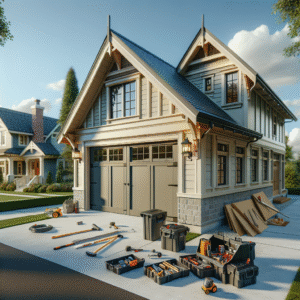When it comes to home improvement, one aspect that often gets overlooked is driveway drainage. However, proper drainage is crucial to maintaining the integrity of your driveway and surrounding areas. A well-chosen driveway channel can prevent water accumulation, minimize erosion, and protect your property from potential water damage. In this blog, we’ll explore the key factors to consider when choosing the right driveway channel, ensuring that your investment serves its purpose effectively and lasts for years to come.
1. Understanding the Importance of Driveway Drainage
Before diving into the specifics of choosing a driveway channel, it’s important to understand why driveway drainage is essential. When rainwater or melting snow is not properly directed away from your driveway, it can lead to several issues:
- Water Accumulation: Without adequate drainage, water can pool on the surface of your driveway, leading to potential safety hazards, such as slippery conditions. Over time, standing water can also cause cracks and deterioration of the driveway material.
- Erosion: Water that flows unchecked across your driveway can erode the surrounding soil, leading to uneven surfaces, sinkholes, and damage to landscaping.
- Foundation Damage: Inadequate drainage can cause water to seep into the foundation of your home, leading to structural damage, mold growth, and costly repairs.
Installing a driveway channel is a proactive measure to prevent these problems by efficiently directing water away from your driveway and property.
2. Types of Driveway Channels
There are several types of driveway channels available, each with its own set of benefits and considerations. Understanding the different options will help you choose the one that best suits your needs.
- Linear Channel Drains: Linear channel drains, also known as trench drains, are long, narrow drains that run across the width of your driveway. They are typically made of concrete, plastic, or metal and feature a removable grate on top to prevent debris from entering the drain. Linear channel drains are highly effective at capturing large volumes of water and are ideal for driveways with a significant slope or areas prone to heavy rainfall.
- Slot Drains: Slot drains are similar to linear channel drains but have a much narrower opening. They are often used in areas where aesthetics are a priority, as the narrow slot is less noticeable than a traditional grate. Slot drains are ideal for driveways where water flow is minimal or where the visual impact of the drainage system needs to be minimized.
- French Drains: A French drain is an underground drainage system that consists of a perforated pipe surrounded by gravel. While not a traditional driveway channel, French drains can be installed along the edges of a driveway to collect and disperse water. They are particularly effective in areas with poor soil drainage or where water tends to pool.
- Permeable Pavers: Permeable pavers are an alternative to traditional driveway channels. These specially designed pavers allow water to pass through them and into the ground below, reducing runoff and promoting natural drainage. Permeable pavers are ideal for environmentally conscious homeowners who want to minimize their impact on the local water table.
3. Material Considerations
The material of your driveway channel is a critical factor in its durability, maintenance, and overall performance. Here are some common materials used in driveway channels:
- Concrete: Concrete channels are known for their strength and durability, making them a popular choice for high-traffic areas. They are resistant to weathering and can handle heavy loads, such as vehicles driving over them. However, concrete channels can be prone to cracking over time, especially in areas with freeze-thaw cycles.
- Plastic: Plastic driveway channels are lightweight, easy to install, and resistant to corrosion. They are also more affordable than other materials, making them a cost-effective option for many homeowners. However, plastic channels may not be as durable as concrete or metal, and they may require more frequent replacement in high-traffic areas.
- Metal: Metal driveway channels, often made of stainless steel or cast iron, are extremely durable and can handle heavy loads. They are resistant to corrosion and are ideal for areas with high traffic or industrial applications. However, metal channels can be more expensive and may require more maintenance to prevent rust.
- Polymer Concrete: Polymer concrete is a composite material made from a combination of resin and aggregate. It offers the durability of concrete with added resistance to chemicals and environmental factors. Polymer concrete channels are ideal for driveways exposed to harsh conditions or heavy chemical use.
4. Sizing and Capacity
Choosing the right size and capacity for your driveway channel is crucial to its effectiveness. The size of the channel should be based on the expected volume of water it will need to handle, as well as the slope and length of your driveway.
- Width and Depth: The width and depth of the channel will determine how much water it can collect and direct away from your driveway. For areas with heavy rainfall or large surface areas, a wider and deeper channel may be necessary. Standard widths for residential driveway channels typically range from 4 to 12 inches.
- Flow Rate: The flow rate of the channel is determined by the slope of the driveway and the capacity of the channel. A steeper slope will increase the speed of water flow, requiring a channel with a higher capacity. Conversely, a flat driveway may need a wider channel to accommodate slower-moving water.
- Grate Selection: The grate on top of the channel is another important consideration. The grate should be strong enough to support the weight of vehicles while allowing water to flow freely into the channel. Grates come in various designs, from simple bars to decorative patterns, and can be made from materials such as metal, plastic, or composite.
5. Installation Considerations
Proper installation is key to the performance of your driveway channel. Here are some important factors to keep in mind:
- Location: The location of the channel is crucial to its effectiveness. It should be placed at the lowest point of your driveway or at the entrance to direct water away from the surface. Consider the natural slope of the driveway and surrounding areas when determining the best location for the channel.
- Slope: The channel should have a slight slope to ensure water flows efficiently towards the drainage outlet. A slope of 1-2% is typically sufficient for most driveways. Improper slope can lead to standing water in the channel, reducing its effectiveness.
- Foundation: A stable foundation is essential for the longevity of the driveway channel. The channel should be installed on a solid base, such as compacted gravel or concrete, to prevent shifting or settling over time. This is particularly important for areas with heavy traffic or extreme weather conditions.
- Connection to Drainage System: The channel must be connected to an appropriate drainage system, such as a storm drain or soakaway, to ensure that water is effectively removed from the area. Improper connection can lead to water backup and potential flooding.
6. Maintenance and Longevity
Once your driveway channel is installed, regular maintenance is necessary to keep it functioning properly and extend its lifespan.
- Regular Cleaning: Over time, debris such as leaves, dirt, and gravel can accumulate in the channel and grate, reducing its efficiency. Regular cleaning is essential to prevent blockages and ensure proper water flow. Depending on the design of the channel, this may involve removing the grate and clearing out any debris.
- Inspection: Periodically inspect the channel and surrounding areas for signs of damage, such as cracks, shifting, or rust. Early detection of issues can prevent more extensive damage and costly repairs.
- Sealing and Coating: For channels made of metal or concrete, applying a protective sealant or coating can help prevent corrosion and weathering. This is especially important in areas with harsh climates or exposure to chemicals.
Conclusion
Choosing the right driveway channel is a critical aspect of maintaining your property’s drainage and preventing water-related issues. By considering factors such as the type of channel, material, sizing, and installation, you can ensure that your driveway remains safe, functional, and visually appealing. Proper maintenance will also extend the life of your driveway channel, protecting your investment for years to come. Whether you’re installing a new driveway or upgrading an existing one, taking the time to select the right drainage solution will pay off in the long run.








